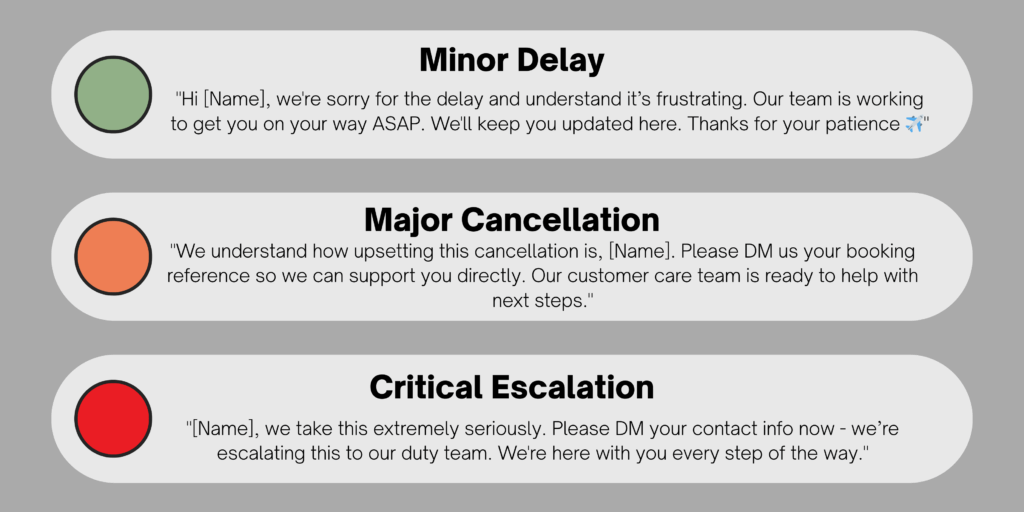In the world of air travel, delays, cancellations, and disruptions are inevitable. But in today’s digital-focused environment, how airlines or travel companies respond to these events on social media can make or break their brand reputation. Social platforms are no longer just a marketing channel; they are the frontline of customer service and crisis communication. One poorly handled tweet can spiral into a PR nightmare, while a well-crafted response can turn a disgruntled traveller into a loyal advocate for the brand.
This blog will look at how global airline teams can build a practical social media playbook for managing high-stress incidents with empathy, speed, and consistency. From templated responses to escalation paths, here’s how to navigate the turbulence with confidence.
Why Social Media is Your Frontline
When flights are grounded emotions are usually high, and customers often turn to social media before any other channel. The immediacy and public nature of these platforms mean your response -or lack thereof – is visible to thousands, sometimes millions, of potential passengers. A swift, human, and helpful reply can de-escalate tension, while silence or generic, ‘one-size-fits-all’ responses can increase frustration.
Examples of viral airline mishaps highlight just how fast things can go wrong: from passengers live-tweeting poor treatment to TikToks showcasing airport chaos, the reputational stakes are high. This makes real-time, empathetic social engagement not just beneficial – but essential.
Real‑World Example: Alaska Airlines’ IT Outage – July 2025
In July 2025, Alaska Airlines experienced a critical IT outage caused by the failure of third‑party hardware. Roughly 150 flights were cancelled with dozens more delayed – affecting around 15,600 passengers after a system‑wide ground stop.
✅ What Alaska did right on social media:
-
Immediate acknowledgment on Socials. They quickly issued statements explaining the nature of the outage, apologised sincerely, and guided customers to check updates.
-
Transparent updates: Instead of downplaying the incident, they communicated clearly about delays, cancellations, and the recovery process.
-
Practical support messaging: Posts included information about hotel and meal vouchers, rebooking processes, and guidance to save receipts – a helpful, customer-focused approach.
-
Empathy and tone: Their messaging acknowledged passengers’ stress, offering human, empathetic language rather than sterile or templated responses.
🚫 What could’ve failed (and how to avoid it):
Some passengers shared frustration on social media, describing hours stuck on tarmacs, lack of clear updates, and service-level confusion. Without a robust response strategy, these posts risked snowballing into negative sentiment and seriously damaging brand reputation in the process.
Core Elements of an Airline Social Playbook
To manage reputational risk effectively, your social media team needs a robust playbook. Here are the key components:
- Pre-approved Copy Equip your team with templated language for common scenarios:
- Apologies for delays or cancellations
- Clear, concise status updates
- Requests for DMs to resolve issues privately
- Tone of Voice Guidelines Your tone should be calm, empathetic, and sincere. Avoid overly robotic language; aim for a conversational yet professional style that reflects your brand values. Staying authentic is key.
- Escalation Framework Define when and how to escalate issues:
- Severe complaints (e.g., medical emergencies, children traveling alone)
- Mentions of media or legal threats
- High-profile users or influencers
- Response Tiers Based on Severity Categorise incidents into tiers:
- Mild: Flight delays under 2 hours
- Moderate: Missed connections, long delays
- Critical: Cancellations, safety concerns
- Internal Roles & SLAs Clarify who is responsible for each type of response, and establish service-level agreements (SLAs) for timing:
- First response within 10 minutes
- Escalation within 30 minutes
- Full resolution or follow-up within 1 hour
Real-World Response Templates
Here are examples of how to tailor your copy to the situation:

Using these templates ensures consistency across channels while allowing your team to act quickly and confidently.
Crisis Protocol: When Social Becomes a PR Emergency
Sometimes, a complaint becomes more than just a customer service issue – it turns into a crisis. When this happens:
- Alert your PR and legal teams immediately.
- Activate a crisis communication plan: pin relevant tweets, update bios with help links, publish real-time updates.
- Use cross-channel coordination: ensure your website, app, and social accounts all reflect the same message.
Establish a “social war room” for real-time collaboration and decision-making across departments. The faster and more unified your response, the better your chances of controlling the narrative.
Cultural & Regional Sensitivity
Global airlines serve diverse audiences. What’s acceptable in one market may come off as insensitive in another. Your playbook should include:
- Localised tone guidelines
- Response templates in multiple languages
- Culturally aware escalation practices
For example, apologies in Japan may require more formality than in the US. Having region-specific guidelines ensures respectful and effective communication worldwide.
From Risk to Opportunity
Social media is a powerful tool for managing reputational risk – but only when backed by a solid plan. High-stress incidents don’t have to end in brand damage. With the right playbook, your business can turn moments of frustration into demonstrations of care, competence, and customer focus.
Don’t wait for the next storm to hit. Build your social media response playbook today – and be ready to meet turbulence with clarity and confidence. Need a hand? Our team are happy to help enquire about Community and Social Media Management packages





